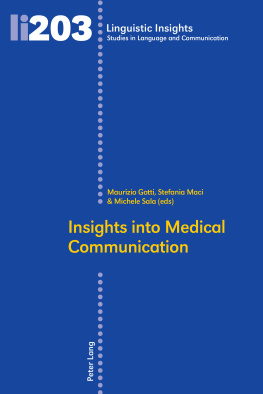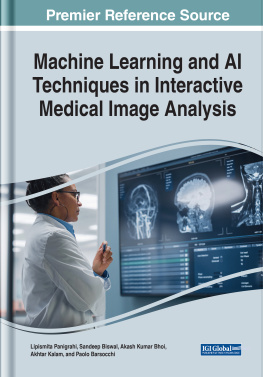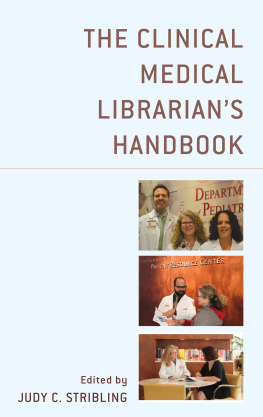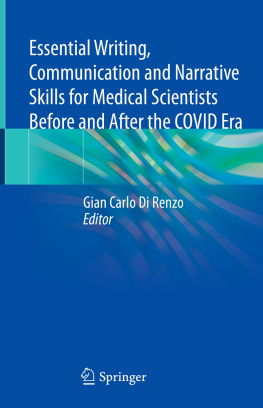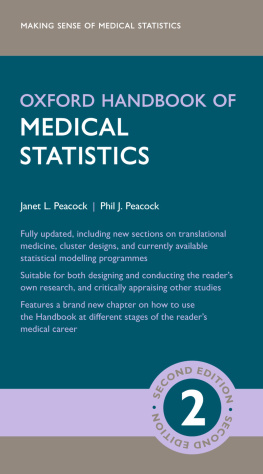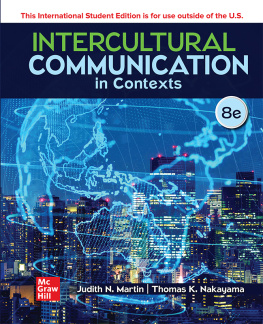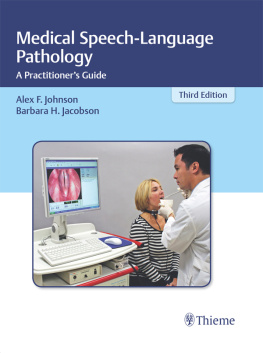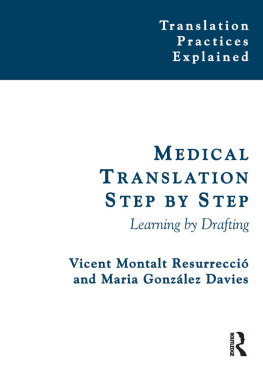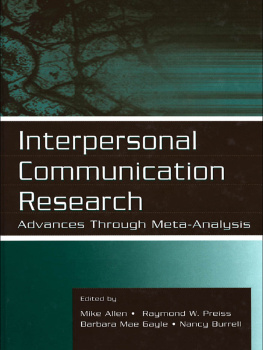Maurizio Gotti, Stefania Maci & Michele Sala (eds)
Insights into Medical Communication


Bern Berlin Bruxelles Frankfurt am Main New York Oxford Wien
Linguistic Insights

Studies in Language and Communication
Edited by Maurizio Gotti,
University of Bergamo
Volume 203
ADVISORY BOARD
Vijay Bhatia (Hong Kong)
David Crystal (Bangor)
Konrad Ehlich (Berlin / Mnchen)
Jan Engberg (Aarhus)
Norman Fairclough (Lancaster)
John Flowerdew (Hong Kong)
Ken Hyland (Hong Kong)
Roger Lass (Cape Town)
Matti Rissanen (Helsinki)
Franoise Salager-Meyer (Mrida, Venezuela)
Srikant Sarangi (Cardiff)
Susan arevi (Rijeka)
Lawrence Solan (New York)

Bern Berlin Bruxelles Frankfurt am Main New York Oxford Wien
Bibliographic information published by die Deutsche Nationalbibliothek
Die Deutsche Nationalbibliothek lists this publication in the Deutsche Nationalbibliografie; detailed bibliographic data is available on the Internet at http://dnb.d-nb.de.
British Library Cataloguing-in-Publication Data: A catalogue record for this book is available from The British Library, Great Britain
Library of Congress Control Number: 2015942051
Published with the support of Dipartimento di Lingue, Letterature Straniere e Comunicazione, Universit di Bergamo, Italy.
ISSN 1424-8689 pb.
ISBN 978-3-0343-1694-1 pb. | ISSN 2235-6371 eBook
ISBN 978-3-0351-0844-6 eBook |
This publication has been peer reviewed.
Peter Lang AG, International Academic Publishers, Bern 2015
Hochfeldstrasse 32, CH-3012 Bern, Switzerland
info@peterlang.com, www.peterlang.com
All rights reserved.
All parts of this publication are protected by copyright.
Any utilisation outside the strict limits of the copyright law, without the permission of the publisher, is forbidden and liable to prosecution.
This applies in particular to reproductions, translations, microfilming, and storage and processing in electronic retrieval systems.
About the author
Maurizio Gotti is Professor of English Language and Translation, Head of the Department of Foreign Languages, Literatures and Communication, and Director of the Research Centre for LSP Research (CERLIS) at the University of Bergamo. His main research areas are the features andorigins of specialized discourse.
Stefania Maci is Associate Professor of English Language and Translation at the University of Bergamo, where she teaches English linguistic courses at graduate and undergraduate level. Her research is focused on the study of the English language in academic and professional contexts, with particular regard to the analysis of medical, legal and tourism discourse.
Michele Sala is a researcher in English Language and Translation at the University of Bergamo. His research activity deals with language for specific purposes and, more specifically, with legal-academic discourse and the linguistic, textual and pragmatic aspects of legal translation.
About the book
This book analyses the subject of medical communicationfrom a range of innovative perspectives, covering a broad spectrum of approaches and procedures that are particularly significant in this field. In this volume, medical communication is analyzed from various viewpoints: not only from a merely linguistic angle, with a focus on the description of the genres used in medical and healthcare contexts, but also from a social and cultural standpoint, with an emphasis both on the doctor-patient relationship and on the social relevance of the other types of communicative links existing between the many communities involved in this type of interaction. The study of some of the main fields typical of medical communication has highlighted a considerable variety of themes, data and research methods which are clearly representative of the eclectic interest in this specific domain and of the wide range of approaches developed for its investigation. As the various chapters show, linguistic analysis proves to be highly applicable to textualizations involving multiple interactions and practices, and several kinds of participants, including different healthcare professionals, trainees and patients.
This eBook can be cited
This edition of the eBook can be cited. To enable this we have marked the start and end of a page. In cases where a word straddles a page break, the marker is placed inside the word at exactly the same position as in the physical book. This means that occasionally a word might be bifurcated by this marker.
Contents
1. Investigating medical communication
Medical knowledge is represented, conveyed and questioned through communicative practices. However, the relation between medicine and communication is complex. Despite the fact that knowledge is still commonly transferred and disseminated through language, medical knowledge implies the exploitation of other means of communication, such as formulae, graphs, images, etc. as well as other communicative modes, such as traditional academic and popular genres, in addition to newly-emerging procedures offered by information technology.
Medical discourse is not just a matter of communicating with patients, about patients, and for patients. Indeed, this specialised type of communication is a very complex phenomenon, mainly relying on the fact that practitioners and researchers need to communicate in different ways, for different aims, and to different targets. As rightly pointed out by Hyland (2004, 2011), the ways in which members of the various disciplines communicate encompass different viewpoints embracing both the issue under investigation as well as their standpoints on that issue. For this reason, specialists employ as many registers as possible according to the many different options available so as to target the various audiences they need to address. Furthermore, in order to reach their goals, they need to exploit a number of interdisciplinary and multimodal strategies, both in public and in private interactions.
This new trend, therefore, has led investigators of medical communication to take into consideration newer theoretical perspectives, and to adopt a more varied range of methodological approaches. Indeed, in communicating medical research findings, this new trend has promoted the recourse to a more open genre network (Swales/Feak 2000) of 9 | 10 academic writing, which includes besides the well-established and visible public research genres such as research articles, abstracts, or conference proposals more modern communicative procedures such as posters, research letters and blogs (Maci 2012a, 2012b; DAngelo 2012) in addition to newer forms of popularization, by means of which medical science can be disseminated to laymen as well to practitioners not belonging to the same professional sector (Myers 2003; Gotti 2014).
One of the challenges in medical communication studies is the ethnographic positioning of the applied linguist when studying specialised discourse in professional domains. As Sarangi states in this volume, professional practice is not easily reducible to mere language or communication because it relies on different layers of understanding involving scientific, organizational and technological knowledge, all of them explicitly realized by different discourses and not immediately recognizable at a linguistic level. This perspective has given way to a vast literature concerning the relationship existing between medical communication and professional settings. Just to quote a few contributions, we can cite: Sarangi/Roberts (1999), who propose an interdisciplinary approach to professional talk and its role in institutional settings, while offering theoretical and methodological tools for further linguistic analysis; Candlin/Candlin (2002), who focus on the discoursal strategies employed by both professionals and laymen in the achievement of rhetorical and professional goals; Roberts/Sarangi (2005), who provide an ethnographic approach to discourse analysis in order to reveal how language constructs professional practices; Gotti/Salager-Meyer (2006), who analyse both oral and written communication in medical discourse in professional settings; Garzone/Sarangi (2007), who consider issues of ideology in specialised communication in various professional, institutional and disciplinary settings, medicine included; Sarangi/Candlin (2011), who investigate medical professional practice from a linguistic standpoint.
Next page
